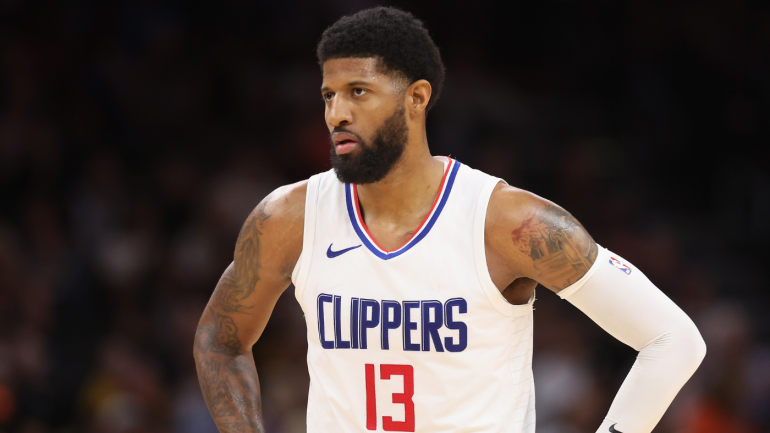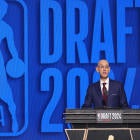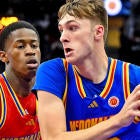
NBA teams have a rich history of misinterpreting new rules. The 2011 collective bargaining agreement scared the Oklahoma City Thunder into trading away James Harden before he could become James Harden. They were afraid that the new luxury tax rules would make retaining him, Kevin Durant, Russell Westbrook and Serge Ibaka unsustainable. Five years later, when a new television deal led to a historic 34% cap spike, teams spent like there was no tomorrow under the assumption that the cap would keep growing forever. It didn't, and players like Joakim Noah, Timofey Mozgov, Chandler Parsons and Ian Mahinmi clogged cap sheets for years.
The summer of 2024 is set to be a somewhat rare convergence of these two phenomena. We're one year into a new CBA that has introduced an entirely new slate of rules into the equation. We're one year away from a new television contract kicking in that will reportedly pay the NBA $76 billion over 11 years and change the league's financial outlook for more than a decade to come. Teams typically struggle to appropriate handle one change of this magnitude. Now the league is dealing with both.
Teams have predictably approached this chaos with caution. That's putting it mildly. Everybody except for Mat Ishbia seems terrified of the new second apron. And, well, that stance is justified. The second apron is the single most restrictive roster-building rule that the NBA has instituted since the invention of the salary cap. Here is a list of ways it limits teams that cross that line:
- No access to the taxpayer mid-level exception. These teams can only sign players for the minimum.
- No access to buyout players. If a player's salary at the beginning of a league year is above the non-taxpayer mid-level exception, he cannot sign with a second-apron team if he is waived during that season.
- No aggregating salaries in trades. Basically, you can't trade two $20 million players for a $40 million player, or a $40 million player and a $10 million player for two $25 million players.
- No flexibility in matching salaries through trades. Second-apron teams must send out as much or more money than they are taking back in any trade.
- No giving away cash in trades.
- No sign-and-trading your own players in exchange for other players.
- No trading first-round picks that are seven years away. These picks become "frozen," meaning they cannot be traded, and if a team spends more than two consecutive years above the second apron, those picks automatically move to the end of the first round.
- While this isn't specifically an apron rule, it's worth noting that the league's luxury tax rate model is changing in the 2025-26 season. In short, it will be cheaper to pay the tax if you're only slightly over the line, but far more expensive to pay it if you're far enough above the line to be considered a second-apron team. This is especially true if you are also a repeater tax team.
If all of that is too complicated, here's the short explanation: once you've crossed the second apron, you're probably stuck with the roster you have short of minor changes, and it's hard to imagine any team spending more than two straight years above the line and knocking their own future picks to the end of the first round.
There have been reports of teams essentially treating the second apron as an informal hard cap. Everyone appears horrified by the idea of adding long-term money and risking incurring the second apron's wrath. The Athletic's Anthony Slater noted that the word around the league is that veterans who are about to become free agents should mostly expect to receive short-term offers. That would explain why Malik Monk chose to re-sign with the Sacramento Kings for $78 million over four years when earlier reports hinted that he would likely get bigger offers elsewhere.
This is even impacting players at the All-Star level. Brandon Ingram was once the centerpiece of the Anthony Davis trade and a cornerstone for the New Orleans Pelicans. Now they reportedly do not want to give him a max extension. Players like Trae Young and Karl-Anthony Towns have been in the rumor mill in part because of max extensions they've already signed. Teams are acting as though one bad contract is a one-way ticket to second-apron hell.
And this is where the new TV deal has been sorely under appreciated. Yes, the rules now punish teams for giving out bad contracts more than ever ... but they also reward teams more than ever for handing out good ones. Why? Because of a rule that came as a direct response to the 2016 cap spike and the disaster that followed.
The cap rose 34% between the 2015-16 and 2016-17 seasons. It rose a total of 8% combined in the next two years, and then only another 10% or so in the next three years combined because of the COVID-19 pandemic. Why is this a problem? Because NBA contracts allow for annual raises. Those raises can be up to 8% for players who re-sign with their own teams and 5% for players who sign with new teams. These raises are locked in when contracts are signed, and virtually every free agent in the summer of 2016 had the leverage to demand them because there was so much available cap space that summer that if one team wasn't offering them, they'd simply move on to another. These raises are fine when the cap rises with them, but as we covered, it wasn't doing so. The NBA injected all of that shiny new TV money into the cap at once. Free agents made out like bandits. And then, with each passing year, those contracts grew more and more toxic because they were rising more than the cap was, effectively making them even more expensive on a relative basis.
That's not happening this time around. The NBA has instituted cap smoothing, meaning that the salary cap can no longer rise by more than 10% in any given year. The new TV deal is so enormous that the widespread expectation is that it will rise by that 10% every year moving forward. Remember, that 10% compounds whereas contractual raises do not. Why is that so important? Because 10 is a bigger number than eight or five. The cap is going to rise faster than contracts can grow with it. In other words, the longer you sign a player now, the more relative value you can squeeze out of those deals at the end of them. They are worth a smaller and smaller percentage of the cap each year.
Here's an example. Say, hypothetically, Paul George were to sign a four-year max contract with the 76ers this offseason. That contract would obviously be expensive, and it would obviously carry meaningful risk given his age and injury history. On paper, he would be earning more money each season. In practice, he would be earning a lower percentage of the projected cap each year. Here's how the numbers look:
Year | Salary | Projected salary cap | Percentage of salary cap |
2024-25 | $49,350,000 | $141,000,000 | 35% |
2025-26 | $51,817,500 | $155,100,000 | 33.4% |
2026-27 | $54,285,000 | $170,610,000 | 31.8% |
2027-28 | $56,752,500 | $187,671,000 | 30.2% |
This contract would start at 35% of the cap, but by the end, it would barely take up 30%. Of course, a 34-year-old free agent like George would be expected to decline throughout the course of that deal and perhaps not be worth 30.2% of the cap by the fourth year. But is that true of all free agents? Monk, for instance, is only 26. He'll be 30 at the end of the deal he just signed and, barring injuries, will likely hold similar value. He was an internal free agent, so he gets 8% raises instead of the 5% George would get by leaving the Clippers, but here's a look at the relative value that is coming in his deal.
Year | Salary | Projected salary cap | Percentage of salary cap |
2024-25 | $17,405,203 | $141,000,000 | 12.3% |
2025-26 | $18,797,619 | $155,100,000 | 12.1% |
2026-27 | $20,190,035 | $170,610,000 | 11.8% |
2027-28 | $21,582,451 | $187,671,000 | 11.5% |
As you can see, the relative value boost isn't quite as strong with internal free agents, but Monk should still be expected to earn a lower percentage of the cap by the end of his deal than he will at the beginning of it. And the Kings were notably limited in what they could offer Monk because they only had Early Bird Rights on him. They had to give him the full 8% annual raises just to meet his overall figure.
But cap space teams? They can get far more creative. Some teams, most notably the Knicks, have made a habit of going the other way. They agree to deals with players based on the overall figure but insist on structuring the deal as they see fit. This often means having the contract drop by 8% annually instead of rising by that much. Their biggest win with this format was Jalen Brunson. He signed a four-year, $104 million deal in 2022 that dropped by 8% after the first and second season before stabilizing for the final player-option year. Let's pretend some team signed a player to an identical contract this offseason. How would that look from a relative perspective?
Year | Salary | Projected Salary Cap | Percentage of salary cap |
2024-25 | $27,733,332 | $141,000,000 | 19.7% |
2025-26 | $26,346,666 | $155,100,000 | 17% |
2026-27 | $24,960,001 | $170,610,000 | 14.7% |
2027-28 | $24,960,001 | $187,671,000 | 13.3% |
Opportunities like this are available all across the NBA right now. The expectation of stable, annual cap growth means that teams should feel relatively comfortable signing long-term contracts at the moment because those contracts are going to cost them a thinner and thinner slice of the overall cap pie with each passing year.
Does this mean teams should be spending recklessly? Of course not! The second apron still exists and still carries all of those scary restrictions. It's just that teams are apparently operating almost entirely in response to those restrictions while ignoring the cap growth that's going to come with them. If you overpay the wrong player now, it's going to sting, but that has always been the case. If you properly pay or underpay the right player, though, you've locked in a bargain at a time in which bargains have never been more valuable. In the interest of sustaining long-term depth in the face of the second apron, you could therefore argue that the optimal approach to contracts moving forward will be handing out long-term deals so you can reap the rewards that come at the end of them.
Every player and every team is ultimately going to be different. By all means, offer short-term contracts to older or injury-prone players. Extra caution is especially warranted on max-level players, because a miss on one of them can be downright disastrous. But aggression is going to be warranted on younger and healthier starters, because if you get those contracts right, you're going to create a ton of surplus value at a moment in which all of your competitors are afraid to try to do the same.


















